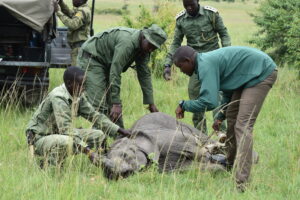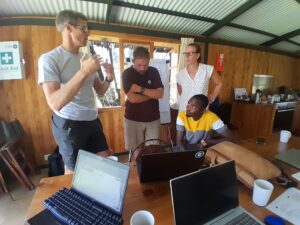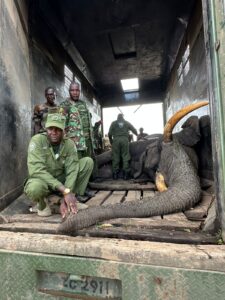The third quarter at Mara Elephant Project was a good example of the complexities of our mission and the true difference between the intense human-elephant conflict (HEC) seasons and other times of the year. July was harvest in the Mara and with ripe crops and little to no rain, elephants were extremely tempted to crop raid and our number of HEC responses was greatly increased. Compare that to August and September when the harvest season was over and we didn’t use the Karen Blixen Camp Ree Park Safari helicopter much but instead focused on internal ranger operations. Ultimately, we are short on our helicopter budget and having a break from operating these past two months was a welcomed cost savings for the organization.
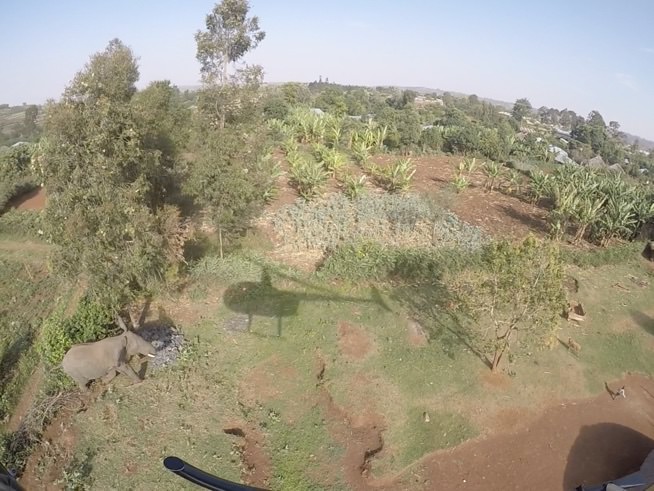
Chasing elephants out of farms on the 28th of July. Note the small child in the right corner of the photo.
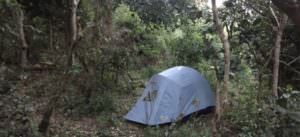 July was so busy that I actually camped out with MEP rangers (pictured left my tent) in the Isokon area of the Transmara so that we could have the helicopter ready at a moment’s notice to mitigate conflict. Large elephant herds were coming up into the farms from the Mara Conservancy as night fell. Rangers would listen for shouts of distress from the farmers and rush to the farms during the night. It was a great community relations opportunity for MEP because the farmers were working with the rangers to coordinate efforts to push the elephants out.
July was so busy that I actually camped out with MEP rangers (pictured left my tent) in the Isokon area of the Transmara so that we could have the helicopter ready at a moment’s notice to mitigate conflict. Large elephant herds were coming up into the farms from the Mara Conservancy as night fell. Rangers would listen for shouts of distress from the farmers and rush to the farms during the night. It was a great community relations opportunity for MEP because the farmers were working with the rangers to coordinate efforts to push the elephants out.
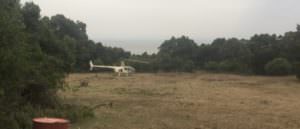
We used the helicopter to move the elephants farther away from the escarpment; pushing them deep into the Mara Conservancy which meant that they would only be able to get to the top of the escarpment by 3 a.m. or not at all. Having me and the helicopter based at the camp (pictured right) my landing pad at camp saved significant ferry time back and forth to the MEP HQ thus reducing the helicopter’s flying hours and overall cost.
In August, because of the lack of funding for the helicopter, MEP had to suspend its monthly aerial monitoring of our 23 collared elephants. The negative impact of this was almost immediate. Collared elephant Nkoidila’s collar dropped off in the Naikara area and re-identifying her and re-collaring her is both expensive and logistically difficult. There is a good chance that if we had continued to monitor her we would have noticed the fraying collar and replaced it before it broke off and we lost the ability to remotely track her and her herd. We additionally had Lucy’s collar break off in the Nyekweri Forest. She was difficult to collar and we will need to work to find and re-collar her or another member of her herd in the thick forest in October or November.
Collared elephant Courtney was successfully treated in August for an old wound and moved safely into the Mara North Conservancy. Hangzhou is proving some interesting movement in that he’s been staging on the base of the Siria Escaprment but luckily has not gone into farms.
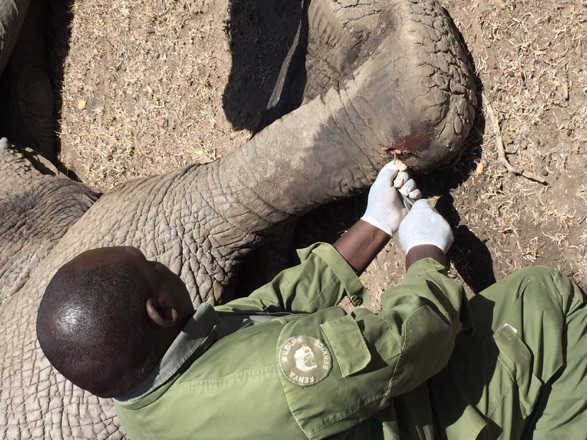
Dr. Limo the vet from KWS/David Sheldrick Wildlife Trust treating Courtney.
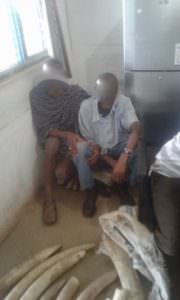
In July, MEP rangers arrested seven poachers and recovered 95 kg of ivory, 44 kg of zebra meat, one leopard skin, and two firearms. In August and September, MEP rangers arrested five suspects and recovered 36 kg of ivory, 33 kg of zebra meat and 30 kg of hippo meat. Additionally, MEP provided intelligence to partner Tanzania National Parks (TANAPA) that led to the arrest of three suspects in Olosokwan village in Tanzania (pictured left). This partnership is proving to be very beneficial to both MEP and TANAPA.
The decrease in human-elephant conflict when harvest season ended meant August and September could be used for some organization housekeeping. We sent MEP reconnaissance units to both the Loita and Mau Forest, held two general staff meetings, re-trained rangers on using the WILD app, held several officer meetings, re-shuffled all patrol teams, and started a new fence monitoring team. We also submitted an application with the Kenya Civil Aviation Authority for two unmanned aerial vehicles (UAVs) to be piloted by me. The application process was rather extensive and needed a number of supporting documentation including UAV insurance, which we were able to purchase.

MEP also updated the website in September to ensure we have the latest organizational information available to our supporters. Along with our website update, MEP updated the logo as well.
At the end of September, in the Transmara and Olongolin areas farmers have started planting which means that our conflict season will start at the end of November. During these low human-elephant conflict mitigation months it’s essential that MEP prepares for the next busy time starting in November. Raising funds for the helicopter, making sure the WILD app is working and recording HEC accurately, buying firecrackers, and ensuring we strategically deploy our mitigation tools and rangers. All these activities are an essential part of MEP completing our mission.
